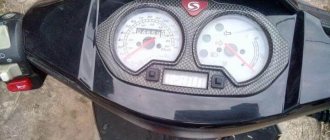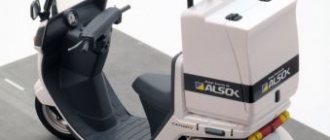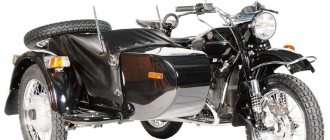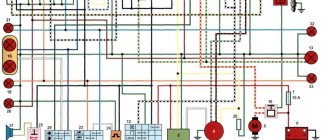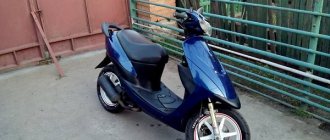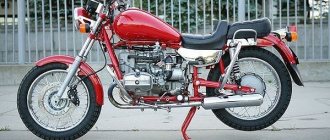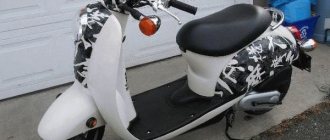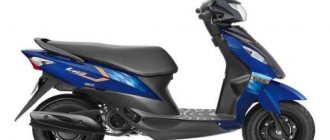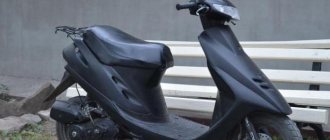If there is any suspicion that the starter is faulty, I immediately remove it from the engine and throw it in the trash. I simply don’t have time to repair such small things. Especially when the motorcycle season is in full swing and everyone needs to quickly get repairs and go about their business.
But, in especially rare cases, I still take on repairing starters, when I come across a rare model of scooter for repair for which it is difficult to find spare parts, or when several faulty starters accumulate, from which I then assemble one.
Repair or diagnosis itself does not present any particular difficulties, even for a beginner. And it will mainly consist of disassembling, washing, checking, cleaning the working surfaces of parts and assembly. But we won’t rush into repairs just yet. Let’s start with general questions, and we’ll touch on the topic of repairs at the very end of the article.
How much does a starter cost for a scooter?
The cost of a starter for a scooter in Russia varies in the range from 950 to 3,043 rubles .
The difference in price is due to the configuration and other technical characteristics. The starter is an integral part of the engine starting system through the use of an electrical circuit that uses a starter relay to separate signals from the control button on the steering wheel. Operation of the relay, followed by activation of the starter, is possible only after pressing the brake handle.
The starter is directly connected by a power wire from the battery, and the second is connected to the frame - ground . Consequently, the product has a contact pad with screw fastenings for wire tips. Unlike a car starter, this one has a protected input of the contact group, so there is no free access of moisture to the copper coins, which can cause them to stick and melt.
In a scooter, the starter is used for simple starting , without using the foot system. The latter does not have a direct connection with the starter, since it directly rotates the piston group of the engine, generating a supply of the air-fuel mixture, as well as sparks.
The starter is made from a distinctive metal cylinder block . This was done for the purpose of economy (the metal has no protection against corrosion), as well as to strengthen the entire structure. The actuation force of the overrunning clutch, actually the Bendix assembly, is 12 J for single-piston engines.
Principle of operation
Inside the body there is a movable cylindrical element called a rotor (in collective farm language - an anchor). An insulated copper wire is wound on the rotor in a strictly defined order, forming several independent coils, circuits, windings, poles, circuits - which, in fact, is the same thing. The ends of each of the coils have their own independent outputs in the form of lamellas (contacts) on the collector.
Inside the main body, two permanent magnets are glued exactly around the rotor. Each of the magnets has a different pole N (north) S (south) in relation to each other. Anyone who went to school will understand...
After you press the start button, the electric current from the battery will begin to pass through the power terminal, the brush and then, passing through the lamellas of one and the rotor windings - it forms a constant magnetic field along the axis of the armature.
I think there is no need to explain that the magnetic field that forms a constant electric current has different polarities? So that's what I'm talking about. Oh yes, the magnetic field of the rotor will begin to interact with the magnetic field of the permanent magnets and the armature will deviate by a certain degree. The commutator will turn, the next pair of lamellas will approach the brushes and the rotor will deviate again. Thus, it will rotate exactly until you lower the start button.
What does the price depend on?
The price of a starter directly depends on the volume of the internal combustion engine. The cheapest models are for single-piston engines with a forced air cooling system. But, in addition to general purpose and compatibility, other factors also influence the cost of the finished product, namely:
Of course, the cost of an electric starter for a scooter is also affected by the brand and country of production. The cheapest are Chinese starters with a warranty of up to one year. An important point is the packaging of the product. Wires, mounting chips, starter circuit damper and the three-position relay itself are best purchased separately. The cost of the kit without the modular hinged unit will not exceed 270 rubles .
Starter starting current
Starter starting current
Posted by chesterbug » Tue Oct 20, 2015 5:56 pm
I’m working on a children’s map, or rather I’m already finalizing it
The machine has a motor from a Ural chainsaw, rebuilt the flywheel - machined the axle and welded this axle to it through a spacer, on which I placed the starter ratchet and a pulley for the generator belt (the issue with the generator itself has not yet been resolved), but today I mated the axle to the VAZ starter 2101 (Bendix converted it to a ratchet), the engine starts just fine from a regular 12V 55A car battery with a button. In short, whoever doesn’t understand - I installed a Ural on a chainsaw motor - a starter for a penny =)
Why does the starter not work on a scooter?
The cost of a starter for a scooter in Russia varies in the range from 950 to 3,043 rubles . The difference in price is due to the configuration and other technical characteristics.
The starter is an integral part of the engine starting system through the use of an electrical circuit that uses a starter relay to separate signals from the control button on the steering wheel. Operation of the relay, followed by activation of the starter, is possible only after pressing the brake handle.
The starter is directly connected by a power wire from the battery, and the second is connected to the frame - ground . Consequently, the product has a contact pad with screw fastenings for wire tips. Unlike a car starter, this one has a protected input of the contact group, so there is no free access of moisture to the copper coins, which can cause them to stick and melt.
In a scooter, the starter is used for simple starting , without using the foot system. The latter does not have a direct connection with the starter, since it directly rotates the piston group of the engine, generating a supply of the air-fuel mixture, as well as sparks.
The starter is made from a distinctive metal cylinder block . This was done for the purpose of economy (the metal has no protection against corrosion), as well as to strengthen the entire structure. The actuation force of the overrunning clutch, actually the Bendix assembly, is 12 J for single-piston engines.
Types and prices of starters
Such a product does not have a specific division into types. The main difference may be the size of the housing, the placement of the contact group, the size and shape of the output shaft. The main classification is carried out by brand. The price category is as follows:
- HONDA – 1,750-3,043 rub.
- IRBIS – 1,129-2,200 rub.
- SUZUKI – 1,600-3,000 rubles.
- YAMAHA – 1,530-3,011 rub.
- Chinese production – 950-1,700 rubles.
YAMAHA
Photo report: Scooter starter repair
If there is any suspicion that the starter is faulty, I immediately remove it from the engine and throw it in the trash. I simply don’t have time to repair such small things. Especially when the motorcycle season is in full swing and everyone needs to quickly get repairs and go about their business.
But, in especially rare cases, I still take on repairing starters, when I come across a rare model of scooter for repair for which it is difficult to find spare parts, or when several faulty starters accumulate, from which I then assemble one.
Repair or diagnosis itself does not present any particular difficulties, even for a beginner. And it will mainly consist of disassembling, washing, checking, cleaning the working surfaces of parts and assembly. But we won’t rush into repairs just yet. Let’s start with general questions, and we’ll touch on the topic of repairs at the very end of the article.
Where is the starter on a scooter?
Finding a starter on a scooter engine is very simple: remove the front plastic hood of the engine and the seat tank, inspect the engine and find a small cylindrical part on it (approximately the same as in the photo) located perpendicular to the longitudinal axis of the engine to which a thick power wire fits - this will be the starter.
On most scooter models, the starter is mounted at the top of the engine, just behind the cylinder. In rare cases, the starter is installed at the front or bottom of the engine.
How to check the starter of a scooter?
If, when you press the start button, the starter does not turn, then this situation cannot always tell us about its malfunction. In addition to the starter itself, the scooter's electrics have several elements that control its operation. Such as the battery, relay, start button and power supply wires. And if at least one of these elements fails, a completely serviceable starter will not work.
Starter diagnostics before replacement
The mechanism can be checked without removing it from the motor. Find the power contact on the case, then disconnect the cable from it. The battery should be removed from the moped, but you must be sure that it is charged. You will need two pieces of copper cable, which should be thick - they are connected to the battery terminals on one side, and the other - the negative wire is connected to the mechanism body, and the positive wire to its power terminal.
Then the following should happen:
- If the device works, this indicates that it is working; accordingly, the cause of the malfunction will be in the relay, ignition switch or wiring that is connected to the device.
- If the mechanism does not start, this indicates its failure. As stated above, there may be several reasons, so the device will need to be dismantled and disassembled (the author of the video is Sanya Slesar).
Kick Starter scooter device
Any scooter, be it Japanese or Chinese, has the ability to start from an electric starter or a kick starter. If the first one doesn’t work for you, which is a very common problem, kickstarter comes to the rescue. Let's look at the reasons for its breakdowns.
Probably 80 percent of scooter owners use kickstarter. Kick means foot, that is, you start the scooter using your foot, which you need to press on the foot located on the variator. And if you often start the scooter this way, the kickstarter may break. The reason may be either poor quality design (most often in Chinese models), or incorrect and rude attitude. Using my own example, I will say that having a Japanese scooter with a kick starter failure there were no problems, while a Chinese two-seater scooter received two kick starter failures in 1 year. If you simply compare the material of both scooters, then even by touch you can see that on Chinese scooters the variator cover or the kick starter itself has very cheap material.
Why does the kick starter break?
There may be several reasons for the breakdown, because they are the ones that most often happen to most scooter riders.
Kickstarter build . If you decide to change the kick starter or another part, be sure to do it correctly. You will need to assemble the spring, retaining rings and other elements according to the instructions. If you miss something, the kick starter leg simply will not return to the right place (see photo).
Worn teeth . Another common failure. If you press the kick starter foot sharply and often, the teeth connecting the foot and the variator will simply wear off, which threatens the same slippage of the foot. The result will be the inability to start the scooter, so keep an eye on the condition of the teeth.
Broken variator cover . Most often it happens with Chinese scooters, which I myself have witnessed more than once. If you press the leg with great force or sharply, the cheap and low-quality material of the variator cover will simply crack around the leg. Here, repairing a variator on a scooter is unlikely to help, as well as welding. The Chinese variator cover is difficult to weld, the weak material does not allow this, so the only option is to buy a variator cover.
We looked at several reasons why the kick starter breaks down; repairing this rather problematic element may take you a little time, but when you have a similar breakdown on the road, you will have to roll the scooter. There may also be three repair options. In the case of cracked teeth, the only possible solution is either replacement or welding. In the case of replacing a kick starter, you simply need to correctly assemble the entire structure, which will be discussed in another article. And if the variator cover is cracked, all you have to do is replace the cover itself. You can try to weld it, but I’ll tell you right away that there is little chance of fixing it this way.
Photo report: Servicing the kickstarter of the Chinese scooter 139QMB (50-80CC)
While the scooter is still new and the factory lubricant remains on the kickstarter parts, the kickstarter works properly: it cranks the engine easily and without slipping, does not creak, and most importantly, after starting it always returns to its place, and does not hang snot.
And as soon as the factory lubricant runs out, the kickstarter parts stick to each other and then problems begin: it creaks, then slips, then does not return to place. I think this situation is familiar to many owners of Chinese scooters, especially scooters equipped with 139QMB series engines.
To avoid this situation, disassemble the kickstarter at least once a season and lubricate its parts. Disassembling and lubricating does not take much time, nothing is particularly difficult there either, so don’t be lazy and service your scooter on time and all technical problems will bypass you.
To disassemble and lubricate the mechanism, you must first remove the variator cover
Then unscrew the bolt on the winding lever, pull it out of the lever and then just remove the lever itself
The shaft that we need is fixed with a retaining ring. We remove the ring with a special puller for retaining rings or we suffer and remove it with the help of a couple of nails and such and such a mother...
There is a thrust washer under the ring - this is a very important device! When disassembling, do not lose it!
Remove the “fungus” from the lid
We take out the shaft with the spring
Before reassembling, carefully wash and lubricate the places where the parts came into contact with the variator cover. You can use any lubricant, but it is better to use copper paste. If you don’t have one, apply regular lithol.
Apply lubricant to the shaft first
Insert the shaft into the cover, wind the spring
Turn the cover over, place a thrust washer on the shaft and secure the shaft with a locking ring.
Lubricate the “fungus” axis
We move the gear sector of the shaft so that the welded tooth goes behind the “fungus”
We insert the “mushroom” into the lid, making sure that its spring bracket fits between the two ledges
This is where our service ends. All that remains is to put the cover back on and put the winding lever on the shaft.
Kickstarter repair on a Chinese scooter with a 157QMJ engine
Typical situation: The winding claw of the Racer Taurus scooter, when pressed, hangs in the pressed position and does not crank the engine. It turns over as if at idle, while some strange sounds are heard from under the variator cover.
The cause of this malfunction lies in the incorrect assembly of the kickstarter mechanism located under the variator cover. Or rather, even in incorrect assembly, and in ignorance of the fact that the variator cover needs to be removed only with the crank removed in advance, leaving the kickstarter shaft in its place.
Beginners usually don’t know this and remove the variator cover along with the crank and shaft, thereby bending the return spring bracket and preventing the correct installation of the shafts. And then they can’t properly assemble the mechanism into a “heap”, so they drive around with the winding claw always not working.
We remove the variator cover, unscrew the bolt on the winding claw and remove it from the shaft.
We remove the starter primary shaft from the cover body.
Do not lose the thrust washer of the kickstarter shaft.
We remove the front variator. The work of removing a scooter's variator is described in detail in the article: How to remove a scooter's variator using available tools
We take out the intermediate shaft, as you can see there are completely no traces of lubricant, which is not good. It is imperative to lubricate all rubbing parts.
The secret to reassembling
To avoid the long and tedious hassle of installing the rotor into the housing, secure the brushes from moving out in their sockets with toothpicks, lubricate the rotor axles with some refractory grease, install the rotor in the housing and remove the toothpicks. This will make it much easier and faster, and most importantly, you won’t break or twist anything.
And one more thing: if after assembly the starter rotates in the other direction, do the following: unscrew the bolts holding the housing together and rotate the housing with magnets 180 degrees relative to the second half of the housing and the problem will go away.
Source
Repairing a kickstarter on a Chinese scooter using improvised means
It is shown how you can eliminate some kickstarter breakdowns using simple means. more info on the page - valeraprivalov.ru/problemyi-s-kikstarterom-na-skutere-super-sport-acar/
Comments
This is a ratchet from a Suzuki Lets
How did you drill the gear? I tried it manually but there was steel in there
At the end of the season, my kickstarter failed again. The teeth of the crescent were immediately a little scratched and in the end a couple of teeth broke off. then I solved the problem with starting the scooter this way - https://www.youtube.com/watch?v=USmTDyuNiWI
I already had it with a hole. I bought this scooter as a non-running scooter. Kickstarter didn't work. This gear was simply given away and there was no shaft on which it was put on. Perhaps it was pressed onto the shaft, but not much. And of course, drilling is a problem - you need to use a drill with a pobedit tip in a lathe. In order for the gear to spin smoothly on the shaft, everything must be accurate.
I have a problem with the leg, when I start the scooter everything is fine, but after I start it, it’s as if something is rubbing there and there’s a very loud and nasty grinding sound, and it wobbles just like in the video, if you press it to the variator, the noise disappears, but as soon as you let go it's starting, help me, I'm sorry, I'm already for it. I'm scratching my head about the fact that it could be a 4t 50cc engine
Dude, exactly the same problem. Have you solved it? Also, I put my foot against the variator when I’m driving, the sound disappears.
It’s so difficult for me to say what the problem is with your scooter. you need to remove the cover and where it rubs should be visible. perhaps your version of ". It seems like a crescent moon is rubbing against the ratchet due to a bad washer or bushing. - is correct. Perhaps the crescent axle bushings need to be replaced or there may be some other reason. you have to look visually - after all, I only repair my scooter, but mine didn’t have such a problem.
It’s like a crescent moon is rubbing against the ratchet due to a bad washer or bushing, but I’m not sure whether this is due to this or not
Scooter kickstarter repair
Any scooter, be it Japanese or Chinese, has the ability to start from an electric starter or a kick starter. If the first one doesn’t work for you, which is a very common problem, kickstarter comes to the rescue. Let's look at the reasons for its breakdowns.
Probably 80 percent of scooter owners use kickstarter. Kick means foot, that is, you start the scooter using your foot, which you need to press on the foot located on the variator. And if you often start the scooter this way, the kickstarter may break. The reason may be either poor quality design (most often in Chinese models), or incorrect and rude attitude. Using my own example, I will say that having a Japanese scooter with a kick starter failure there were no problems, while a Chinese two-seater scooter received two kick starter failures in 1 year. If you simply compare the material of both scooters, then even by touch you can see that on Chinese scooters the variator cover or the kick starter itself has very cheap material.
Why does the kick starter break?
There may be several reasons for the breakdown, because they are the ones that most often happen to most scooter riders.
Kickstarter assembly
. If you decide to change the kick starter or another part, be sure to do it correctly. You will need to assemble the spring, retaining rings and other elements according to the instructions. If you miss something, the kick starter leg simply will not return to the right place (see photo).
Worn teeth
. Another common failure. If you press the kick starter foot sharply and often, the teeth connecting the foot and the variator will simply wear off, which threatens the same slippage of the foot. The result will be the inability to start the scooter, so keep an eye on the condition of the teeth.
Broken variator cover
. Most often it happens with Chinese scooters, which I myself have witnessed more than once. If you press the leg with great force or sharply, the cheap and low-quality material of the variator cover will simply crack around the leg. Here, repairing a variator on a scooter is unlikely to help, as well as welding. The Chinese variator cover is difficult to weld, the weak material does not allow this, so the only option is to buy a variator cover.
We looked at several reasons why the kick starter breaks down; repairing this rather problematic element may take you a little time, but when you have a similar breakdown on the road, you will have to roll the scooter. There may also be three repair options. In the case of cracked teeth, the only possible solution is either replacement or welding. In the case of replacing a kick starter, you simply need to correctly assemble the entire structure, which will be discussed in another article. And if the variator cover is cracked, all you have to do is replace the cover itself. You can try to weld it, but I’ll tell you right away that there is little chance of fixing it this way.
Source
JavaScript is disabled in your browser
How does a kick starter work?
The scooter engine can be started in two ways:
- using an electric starter;
- using a kick starter.
The kick starter is designed to start the scooter engine and serves as an alternative unit in case of problems with the electric starter. There is also an undeniable advantage of the so-called “pump” the starter pedal and carefully monitor how quickly it returns to its original position. If it slowly and difficultly rises back, or even hangs down, then it’s time to disassemble this scooter assembly and check its parts. Another reason to look inside the kick starter system will be the inability to start the engine using the pedal and the extraneous sounds that arise under the variator cover.
Before disassembling this unit, you need to clean (or wash) the variator cover and wipe it with a clean rag. After this, unscrew the bolts securing the front and back parts of the cover and carefully remove it. Inside the cover is the kick starter system, which must be disassembled. The ratchet is easily removed if you turn the “winding leg” a little and pull it towards you. It contains a washer and an installation bracket, which should be removed and placed in a container of gasoline to clean them. The ratchet should also be cleaned in the same way. The remaining parts of the system and the interior of the variator cover must be cleaned with gasoline using a brush.
After removing dirt, you need to check the parts for chips, abrasion and other damage. Such spare parts must be replaced with new ones. If no damage is found, then the technical inspection in this case will be limited to lubrication of all parts of this system.
To do this, all parts must be thoroughly wiped with a rag and begin lubricating. Using a syringe, you need to inject a special lubricant into the bushing under the crescent for its free rotation. To ensure that the lubricant is evenly distributed inside, press the starter pedal with your hand several times. The teeth of the crescent should also be well lubricated. Solid oil is ideal for this, since its thickness will prevent excessive abrasion of parts during system operation. You should also generously lubricate the bracket, ratchet, and ratchet washer. Now you should reassemble in reverse order and check the operation of the kick starter.
The most common breakdowns
Violation of operating rules and careless handling of the scooter often lead to damage to the variator cover or kick starter leg. If the scooter rider hits the pedal sharply and hard, this may result in the appearance of cracks and breaks in the area where the leg is attached to the variator cover. This is due to the poor quality of the material used in the manufacture of scooter parts. In this case, the variator cover should be replaced. You can purchase high-quality spare parts for this scooter system on the website or in an online store at an affordable price.
Another problem leading to kick starter failure is improper assembly of this scooter system. Therefore, when disassembling this unit yourself, you should be careful and careful not to lose any small part. Also, during assembly, you need to pay special attention to the correct installation of parts such as the ratchet and crescent. A correctly assembled system will function normally, but violations during assembly will lead to rapid wear and breakage of parts.
